Bios 242 week 6 - Study guides, Class notes & Summaries
Looking for the best study guides, study notes and summaries about Bios 242 week 6? On this page you'll find 262 study documents about Bios 242 week 6.
Page 4 out of 262 results
Sort by

-
BIOS 242 Week 6 Lab 2; Bacteria of Respiratory System
- Other • 4 pages • 2023
- Available in package deal
-
- $21.48
- + learn more
Lab12:BacteriaoftheRespiratorySystem Introduction: Therespiratorysystemisdividedintotwoparts:theupperandlowerrespiratorysystems.Thelowerrespiratorysystemisanaxenicenvironmentbecauseof the cilia that lines the respiratory tract, alveolar macrophages and IgA antibodies found in the mucus. The upper part harbors a variety of microbiotasuch as Gram-negative bacteria Hemophilus, Gram-positive bacteria such as Staphylococcus aureus and diphtheroids that can cause opportunisticinfectionsleading toinf...
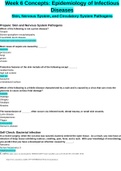
-
BIOS 242 Week 6 Concepts: Epidemiology of Infectious Diseases _Chamberlain
- Other • 4 pages • 2023
- Available in package deal
-
- $15.49
- + learn more
Week 6 Concepts: Epidemiology of Infectious Diseases Skin, Nervous System, and Circulatory System Pathogens Prepare: Skin and Nervous System Pathogens Which of the following is not a prion disease? Scrapie Bovine spongiform encephalopathy Creutzfeldt-Jacob disease Subacute sclerosing panencephalitis Most cases of sepsis are caused by ______. bacteria protozoans fungi prions viruses Protective features of the skin include all of the following except ______. resident biota high sa...

-
BIOS 242 Week 6 Lab 1; Bacteria of the skin
- Other • 6 pages • 2023
- Available in package deal
-
- $25.49
- + learn more
Lab 11: Bacteria of the Skin Learning Objectives: • Identify the growth of skin bacteria on different types of selective and differential media. • Identify pathogenic from non-pathogenic bacteria Introduction: Our skin forms the first line of defense. It has several characteristics that makes it an inhospitable environment for the growth of most microbes. Some of these characteristics of skin include: high percentage of salt, low pH from 4-5.5, sebum, antimicrobial chemicals; an outer...
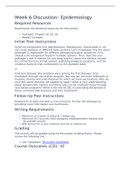
-
BIOS 242 Week 6 Discussion; Epidemiology
- Other • 2 pages • 2023
- Available in package deal
-
- $15.99
- + learn more
Read/reviewthefollowingresourcesforthisactivity: • Textbook:Chapter18,19,20 • WeeklyConcepts InitialPostInstructions Some microorganisms like Staphylococcus, Streptococcus, Yesinia pestis, E. coli cancause diseases of different body systems. Let's investigate how the same pathogen isresponsible for different pathophysiological symptoms. First, choose a microorganismfoundinmultiplesystems.Then,describeyourpathogen'sroleindiseaseforonebodysystem: report the disease caused, the normal f...
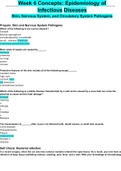
-
BIOS 242 Week 6 Concepts; Epidemiology of Infectious Diseases
- Other • 8 pages • 2023
- Available in package deal
-
- $35.49
- + learn more
Week 6 Concepts: Epidemiology of Infectious Diseases Skin, Nervous System, and Circulatory System Pathogens Prepare: Skin and Nervous System Pathogens • Which of the following is not a prion disease? • Most cases of sepsis are caused by . • Protective features of the skin include all of the following except . • Which of the following is a febrile disease characterized by a rash and is caused by a virus that can cross the placenta to cause serious fetal damage? • The transmissi...

-
BIOS 242 Week 6 Discussion; Epidemiology
- Other • 2 pages • 2023
- Available in package deal
-
- $15.99
- + learn more
RequiredResources Read/reviewthefollowingresourcesforthisactivity: • Textbook:Chapter18,19,20 • WeeklyConcepts InitialPostInstructions Some microorganisms like Staphylococcus, Streptococcus, Yesinia pestis, E. coli cancause diseases of different body systems. Let's investigate how the same pathogen isresponsible for different pathophysiological symptoms. First, choose a microorganismfoundinmultiplesystems.Then,describeyourpathogen'sroleindiseaseforonebodysystem: report the disease c...
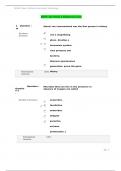
-
BIOS 242 Week 4 Midterm Exam 2023
- Exam (elaborations) • 34 pages • 2023
-
- $20.49
- + learn more
BIOS 242 Week 4 Midterm Exam 1. Question : Antoni van Leeuwenhoek was the first person in history to Student Answer: use a magnifying glass. develop a taxonomic system. view protozoa and bacteria. disprove spontaneous generation. prove the germ theory. Questio n 2 . Question : Microbes that can live in the presence or absence of oxygen are called Student Answer: anaerobes. facultative anaerobes. obligate parasites. archaea. prokaryotes. ] pg. 1 Points Received: 0 of 1 B...
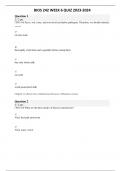
-
BIOS 242 WEEK 6 QUIZ 2023-2024
- Exam (elaborations) • 8 pages • 2023
- Available in package deal
-
- $9.99
- + learn more
BIOS 242 WEEK 6 QUIZ (TCO 10) Feces, soil, water, and even food can harbor pathogens. Therefore, we should routinely . eat rare steak thoroughly wash fruits and vegetables before eating them buy only whole milk eat sushi avoid pasteurized milk Chapter 14, Reservoirs of Infectious Diseases of Humans section (TCO 10) What are the three modes of disease transmission? Viral, bacterial, protozoan Viral, acute, vector Question 1 2 / 2 pts Question 2 2 / 2 pts Vector, vehicle, contact ...

-
BIOS 242 Week 6 Lab 2; Bacteria of Respiratory System
- Other • 4 pages • 2023
- Available in package deal
-
- $20.49
- + learn more
Lab 12: Bacteria of the Respiratory System Introduction: The respiratory system is divided into two parts: the upper and lower respiratory systems. The lower respiratory system is an axenic environment because of the cilia that lines the respiratory tract, alveolar macrophages and IgA antibodies found in the mucus. The upper part harbors a variety of microbiota such as Gram-negative bacteria Hemophilus, Gram-positive bacteria such as Staphylococcus aureus and diphtheroids that can cause opport...
BIOS 242 Week 6 Lab 2; Bacteria of Respiratory System

Study stress? For sellers on Stuvia, these are actually golden times. KA-CHING! Earn from your study resources too and start uploading now. Discover all about earning on Stuvia



